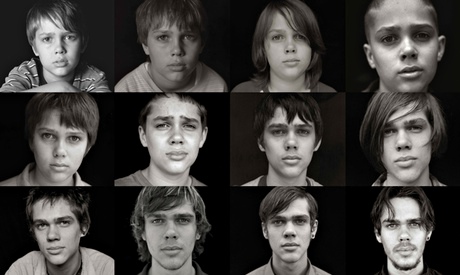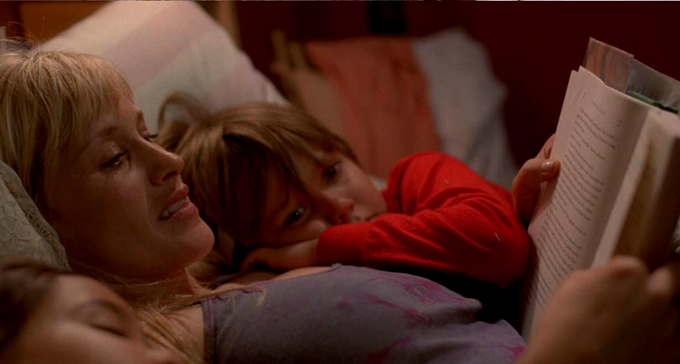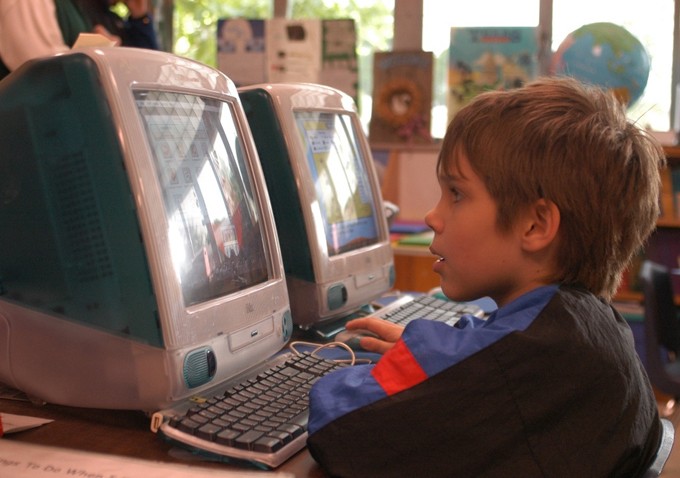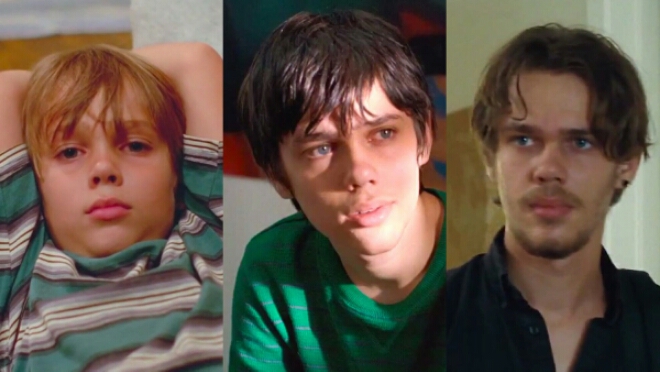How do you chronicle a life? Director Richard Linklater’s latest film is an attempt at tackling that riddle, which succeeds in balancing the breadth of such an undertaking and the intimacy of its results. Filmed over twelve years with the same actors, the production of Boyhood is already the stuff of film legend. The fact that this film even exists is yet more proof that Linklater the director is a master of the form. It is even more impressive, then, that Linklater the storyteller saw the process as but a means to an end. Over twelve curated years, Linklater tells a story of such specificity and veracity that it could not be anything but modest. Ultimately, Boyhood is the simple story of a colorful, believable, and relatable life that is told in the best way possible.
Mason Jr. (Ellar Coltrane) is a six-year-old boy living with his older sister, Samantha (Lorelei Linklater) and his mother, Olivia (Patricia Arquette), in a small Texas town. His mother and father, Mason Sr. (Ethan Hawke), are separated. Over a brisk three hour runtime, we are made witness to a countless number of ups and downs in Mason’s life that come together in a comprehensive collage of snapshots. What happens to him at age six visibly changes how he acts at age seven, and so on. The Mason we meet at age six is a simple character with only the blueprint of a personality. Every year adds dimension and complexity until, at eighteen, we no longer wonder about who he is, what he wants from life, and why he has become is the person he is. Linklater finds creative ground where so many filmmakers before him have only seen logistical restrictions. In solving the puzzle of telling this story, he elevates the slice-of-life genre to a level never before attained and finds dramatic worth in a chapter of human life that so many artists decide to skip. The shaping of Mason is one of the most satisfying character studies ever realized.
While Boyhood focuses lovingly on Coltrane’s growth, it never forgets its other cast members. The twelve years of story time allow each of them a unique richness. Mason and Samantha both go through childhood and adolescence by asking different questions and learning different lessons. The teenagers they become incorporate different shades of the teenagers we might remember knowing (or even being) in college. Their characters are wonderfully distinct summations of their unique experiences.
As established actors, Arquette and Hawke move their characters through more subtle changes which are just as fascinating to track. Their performances are the culmination of dramatic choices playing out patiently over twelve years. Olivia rediscovers her ambition for psychology, cut short by an early marriage. Her many successes in the field and her unfortunate attempts at finding new love mold her into a hardened but emotionally stable mother who loves her children as the perfect, but only, family she has. Mason Sr. is a fun, cool dad with a questionable sense of responsibility. As he continues to spend time with his growing kids, their changing love for him mellows him out. He is able to move on from their mother, becoming a better husband and father to a new family, while continuing to love them all the same. Once again, these gradual but observable changes make the twelve years of Boyhood feel like the greatest thing to happen in narrative film for a long time.
It is interesting to see the children (especially Coltrane) shift in their performances as the years progress. As a young kid, Mason is much less self-conscious, reading off precocious lines like they were nothing, albeit with the awkwardness of a child. As time passes, Coltrane becomes much more conscious of his acting. There are several scenes during his middle school years where we lose some of his childhood energy to newfound, dramatic mumbling. By high school this trait has been absorbed but reexpressed as thoughtful and pretentious philosophizing with the particular charm of a know-it-all teenager. We may never know exactly how much of Coltrane was looped back into Mason over the years by Linklater’s naturalistic writing. Consequently, there is no use in judging his performance along standard criteria due to the uniqueness of when his role begins and when it ends. Still, it is great because of that uniqueness, and it is astounding to step back and see the year-to-year consistency of both Mason’s development and Coltrane’s development as an actor.
Arquette and Hawke are much more easily lauded as being conventionally great. As the constant parent, Arquette subtly navigates the changing nature of her character’s parenting. The support she gives her children changes to match their needs, even as she visibly reacts against her diminishing presence in their lives. The true standout, however, is Hawke, who quite wonderfully steals every scene he’s in. As a veteran of Linklater’s dialogue, his Mason Sr. deftly shifts over the years from the fun dad of the weekends to the reliable and respectable father of the everyday, all without losing any of his character’s core. His loud, jokester personality is one of the film’s highlights and even as he loses his silly casualness, he is still able to make his kids laugh as a more clever and empathetic influence.
As the characters change over time, Linklater delights in showing the changes in America and American pop culture to match. The set dressing of Boyhood creates a time capsule effect as the film rather cutely uses major pop songs, contemporary fads, and the occasional cultural reference to indicate the passage of time. There is nary a title card in the entire movie that explicitly states what year it is, but when we smash cut to a kid on a forgotten skateboard variant, riding to Soulja Boy’s “Crank That,” you just know that it’s 2007. These tricks are not new and most movies immediately feel cheap and artificial as soon as they resort to such methods to date their setting. However, when you consider that Linklater was predicting for cultural longevity in the moment and without the luxury of 20/20 hindsight, you can’t help but be charmed by the glimpses of yesteryear that work (the evolution of video game consoles) and what don’t (several unrecognizable radio hits from the early 00’s).
Boyhood is the story of one boy’s twelve years and how that time was shared with friends and family. To be able to tell such a comprehensive story on such a personal level is an unimpeachable cinematic feat. However, there is a smaller triumph that I believe to be the most important facet of the film’s power; it never feels like it ends. Structurally, the film has no climax. Scenes never conclude with a sense of finality. The overwhelming feeling you get when watching Boyhood is not of defining moments with strong bookends, but rather of good days, bad days, and the general in between that really make up a life. The twelve years we see are vibrant and complete, but it is to the credit of all involved that, when the movie ends, life goes on, and Boyhood was just the beginning.
Boyhood is now playing in select markets, with new locations added every week. Check your local listings to see if the film is playing near you.







I’ve heard a lot about this movie – good things and bad things. This review probably said the most about the style of the movie itself than any other review I’ve read – the “period” details, and the evolution of the kid’s acting. This made me want to see it more than any other review.